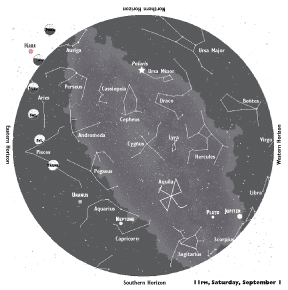|
|
 |
||||||||||
|
|||||||||||
|
|||||||||||
The Planetary ParadeWhile Jupiter dips low, Mars and Venus begin to grow
The waning gibbous moon rises around 9:15pm Friday and about one-half hour later each following night. By Monday the first-quarter moon crests the northeast horizon at 11:15pm, followed 45 minutes by Mars. They first appear about 10 degrees apart, roughly the size of your outstretched fist; by dawn Tuesday the two are high overhead with less than five degrees between them. For months, the red planet has been a dim fixture of pre-dawn skies. Tuesday, it rises before the witching hour of midnight, then a couple minutes earlier each night thereafter. Aldebaran, the red eye of Taurus the bull, glares not quite as bright about 10 degrees below Mars. Not only is Mars rising earlier, it is also growing. Over the next few months the red planet will double in apparent size with its closest pass of earth December 18 and its opposition to the sun December 24. While Mars rises in the northeast, Jupiter sets in the southwest almost in tandem. Before setting, however, Jupiter remains the brightest object other than the moon and setting sun. Look for it in the south-southwest at sunset, around 7:40 this week, with the red giant Antares, the heart of the scorpion, five degrees below. Venus returns to view this week, rising almost due east about an hour before daybreak, around 6:35 this week. Although faint and fleeting this week, the morning star climbs higher each day, rising almost five minutes earlier each morning, while the sun continues to lose ground. On clear, dark summer nights, look for the Milky Way, stretching from Auriga and Perseus through the stars of the Summer Triangle to the scorpion’s tail in the south. Illustration: © Copyright 1925 M.C. Escher/Cordon Art-Baarn-Holland; Graphics: © Copyright 2007 Pacific Publishers. Reprinted by permission from the Tidelog graphic almanac. Bound copies of the annual Tidelog for Chesapeake Bay are $14.95 ppd. from Pacific Publishers, Box 480, Bolinas, CA 94924. Phone 415-868-2909. Weather affects tides. This information is believed to be reliable but no guarantee of accuracy is made by Bay Weekly or Pacific Publishers. The actual layout of Tidelog differs from that used in Bay Weekly. Tidelog graphics are repositioned to reflect Bay Weekly’s distribution cycle.Tides are based on National Oceanic and Atmospheric Administration and are positioned to coincide with high and low tides of Tidelog. |
|||||||||||
|
|||||||||||
|
|
|||||||||||
|
© COPYRIGHT 2007 by New Bay Enterprises, Inc. All rights reserved. |
|||||||||||


